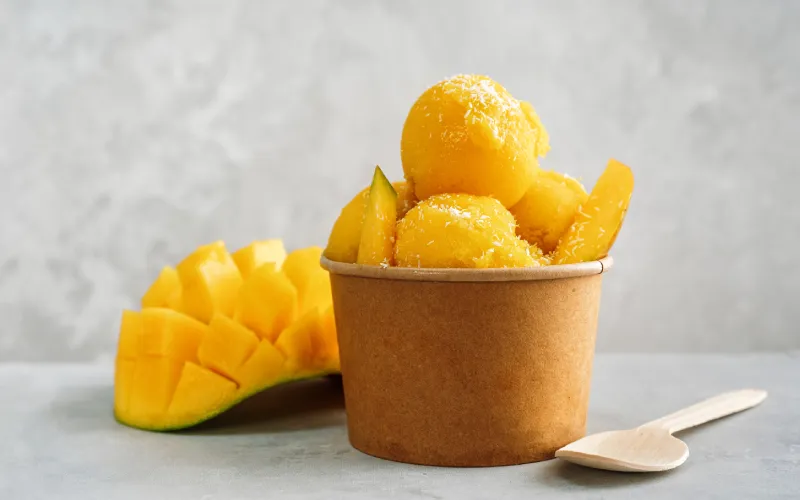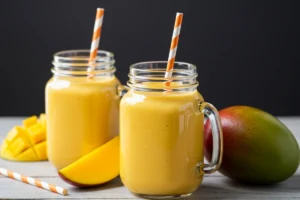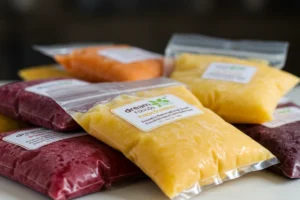Mango sorbet is a refreshing treat that combines the exotic flavor of mango with the smooth and creamy texture of sorbet. This product is ideal for expanding your frozen dessert line.
Industrial mango sorbet recipe
Do you want to add a sweet, refreshing, and tempting option to your product line? Learn how to make sorbets from packaged mango puree:
Ingredients:
- 10 kg mango purée.
- 3 kg of sugar.
- 7 liters of water.
- 300 ml lemon juice.
- 150 g stabilizer for sorbets.
- 1 kg glucose syrup.
Preparation of mango sorbet
These are the steps commonly followed by the food industry to prepare a delicious mango sorbet with natural fruit purees:
- Syrup preparation: in a large saucepan, combine sugar and water. Heat over medium heat until the sugar is completely dissolved and forms a simple syrup. Then, add the glucose syrup and mix well.
- Incorporating the mango puree: in a pasteurization tank, mix the puree with the cooled simple syrup. Next, add the lemon juice, which will help enhance the mango flavor and balance the sweetness of the sorbet. Finally, add the sorbet stabilizer according to the manufacturer’s instructions and mix well to avoid lumps. The blending process takes 15 to 30 minutes.
- Cooling process: cool the mixture to 2 and -4 °C in an industrial sorbet machine.
- Packaging: remember to package the product while it’s still in liquid state before cooling it further.
- Solidification with the buttery machine: this machine is responsible for producing small ice crystals, turning the liquid into a solid. During this process, the fats crystallize, and the stabilizers hydrate. It is crucial to maintain constant agitation during freezing to ensure a smooth and creamy texture. Finally, do not forget to apply the shake for 15 to 20 minutes.
- Storage: once the mango sorbet reaches the desired consistency, transfer it to appropriate storage containers and freeze at -18°C or below. You can leave the mixture to stand for 4 to 24 hours to reach the ideal texture. In the preservation chamber, you must ensure that you preserve the sorbets or ice creams before distribution.
- Distribution: the product must be loaded in trucks with cold containers.
Tips to improve the quality of mango sorbet
Then, follow these recommendations to achieve maximum quality in the final product and ensure your customers’ satisfaction:
- Balance of sweetness and acidity: for example, lemon juice not only enhances the flavor of the mango but also helps prevent sugar crystallization and ensures a smooth texture. Thus, it is important to adjust the amount of lemon juice according to the sweetness level of the mangoes used.
- Use of stabilizers: these help to improve the texture and stability of the sorbet during storage. It is key to use the right amount and mix well to avoid lumps.
- Freezing process: rapid and constant freezing is essential to avoid the formation of large ice crystals, which can affect the texture of the sorbet. Therefore, the use of industrial machines designed for sorbet making is ideal for this purpose.
- Flavor innovation: consider incorporating other complementary flavors, such as fresh herbs (mint, basil) or spices (ginger, cardamom), to create unique and appealing sorbet options.
Importance of raw ingredients
Making a good sorbet involves carefully choosing the fruits, using stabilizers, and quality milk. It is important to know what you want to offer because, depending on this, you can vary any of the ingredients to encourage the consumption of your ice cream. However, it is essential to use the highest quality raw materials to obtain the best possible result:
- The fruit: for example, we recommend using packaged puree to simplify the production process and add a natural ingredient with all the benefits of mango. Using high-quality fruit puree is crucial for an intense and authentic flavor. Mangoes should be sweet and fiber-free for a smooth texture. To ensure consistency and premium quality, it’s advisable to source ingredients from trusted mango puree suppliers or mango concentrate suppliers.
- Milk: a must-have ingredient for making ice cream. If you use a milk with protein, you can vary the consistency of the ice cream. This will make your sorbets more or less consistent.
- Sugar: many companies vary the type of sugar they use for the preparation of sorbets. Likewise, everything will depend on the type of texture you want to give to your products.
Mango sorbet is a delicious and consistent product that has won over more and more consumers in the United States and Canada. Apply these tips and knowledge in your production to achieve exceptional products.
Bibliographic references
- Rodríguez, M. (2023, May 19th). Descubre las mejores recetas de postres con mango. Diez Minutos.
- Heladería.com. (n.d.). El helado fase a fase.
- Scoolinary. (2020, July 6th). El proceso básico de fabricación de helado.






